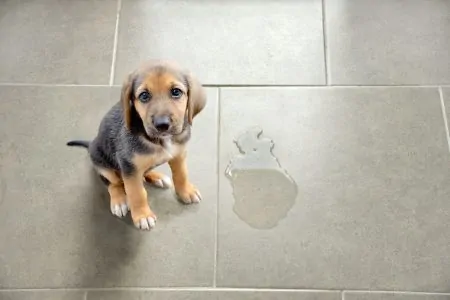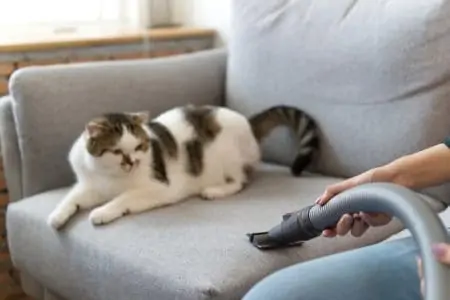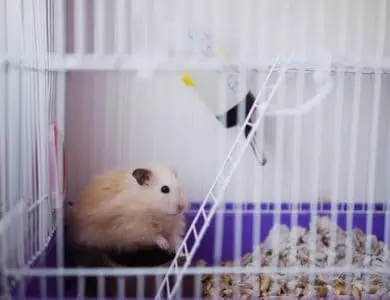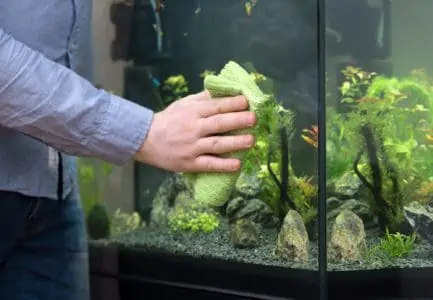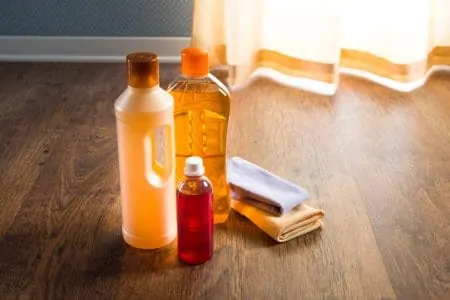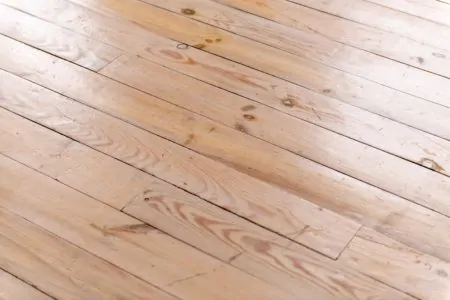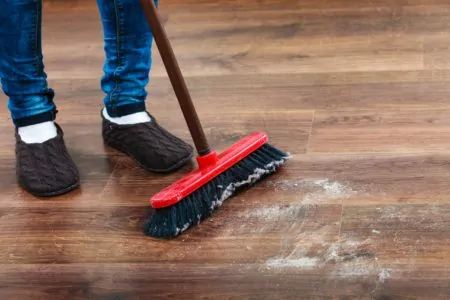There are few things as frustrating as the moment when you get a whiff of pet pee (or worse). Not only is it a hassle to clean up, but it could lead to pesky stains.
We’re pet-owners ourselves, so we feel your pain. Accidents happen. But with years of owning pets, we have found some of the best methods for how to clean pet stains.
With our guide on tackling these messes, you’ll be armed with some solutions. No doubt, you’ll feel more at ease in the future.
Key Takeaways
- Tackle pet stains immediately with white vinegar, grapefruit oil, or a mixture of vinegar and baking soda to remove stains and odors.
- Hydrogen peroxide is a mild bleach that can help clean stubborn pet stains, but use caution when applying it to hardwood floors.
- Enzymatic cleaners are natural and effective for removing pet stains on all types of hard floors, including hardwood.
- Prevent pet stains by training your pet, keeping their litter clean, and sealing your hardwood floors with a high-quality sealer.
How to Clean Pet Stains on Floors
If you’re beginning to notice discoloration and that pungent pet odor on your hardwood floor, you might be too late.
Pet urine can permanently damage hardwood floors, leaving behind a putrid stench. Sometimes the only solution is to replace the floors.
But, before you start to freak out, we’ll show you what you can try.
There are many different methods of removing stains and odors. They work best when you tackle the stains and smells right away. These are some of our favorites:
1. White Vinegar and Grapefruit Oil
Vinegar is a highly acidic product, but in a good way because it’s entirely natural. You can use white vinegar for various purposes, such as cooking and cleaning. Vinegar is also a natural deodorizer and is highly effective at removing pungent odors such as urine (1).
Warning
Grapefruit oil has highly potent antibacterial properties (2). Due to its natural citrus scent, it’s a perfect match to the sourness of vinegar.
Many people avoid vinegar due to its sharp scent. However, when you add grapefruit oil, it takes the edge off of the sourness. The combined solution creates that signature citrus-clean smell we all link to a clean home.
How to Use
Fill a bucket of warm water and add one cup of white vinegar and a few drops of grapefruit oil. Give it a quick mix and start cleaning. Tough stains will require some scrubbing.
Safe to Use On
Vinegar is especially effective at bringing the shine back to hard surfaces.
However, when using on hardwood floors, it’s crucial to be careful. You should never use a lot of water since it can quickly damage the sensitive surface. Instead, you could fill a spray bottle with the solution and immediately wipe it off once done.
2. White Vinegar and Baking Soda
Baking soda is another universal product famous for being tough on stains — and heavenly in cupcakes. In contrast to vinegar, baking soda is highly alkaline (the opposite of acidic) (3). It is considered a mild abrasive cleaner.
So when you combine baking soda and white vinegar, you’re creating a super-cleaner. White vinegar will help to dissolve stains and remove odors, while baking soda will eliminate spots and soak up excess fluids.
How to Use
There are primarily three ways to this method. However, they’re quite similar.
1. Direct Application
Start by sprinkling baking soda directly onto the stain. The baking soda will quickly begin to absorb the stain and possible fluids. Use a soft brush or sponge to rub the area gently; don’t scrub. It could scratch the surface.
Add pure white vinegar to a spray bottle and give the area a few spritzes. If you’re into chemistry, you’ll love to watch this. The mixture will quickly begin to foam and bubble. You can now wipe it using a damp cloth.
2. Creating a Paste
The second method is by creating a paste using vinegar and baking soda. Apply the paste to the affected area and leave it to dry. Once dry, scrape off the excess paste and vacuum the area.
You can also do this using baking soda and water instead of vinegar (4).
3. Make a Spray
Making this baking soda, vinegar, and dish soap spray is great for removing old pet stains and smells. It works on all kinds of wood floors.
In a spray bottle, mix 1/3 cup of distilled white vinegar, 1/4 cup of baking soda, and a drop of dish soap. Spray onto the affected area and let it sit for 15 minutes before wiping with a clean cloth.
Sprinkle some more baking soda over the area and leave it through the night. In the morning, vacuum it up, and hopefully, the odor will be gone.
Avoid Damage
Safe to Use On
We highly recommend this cleaning method for older stains on laminate floors. You can use it on hardwood floors as well. However, be careful when applying baking soda to hardwood flooring.
Don’t Wait
3. Hydrogen Peroxide
Hydrogen peroxide is the simplest peroxide. With its formula being H2O2, this compound is just slightly more viscous than water (H2O).
Some people often confuse hydrogen peroxide with other bleaching agents such as chlorine. However, hydrogen peroxide is considered a “safe” bleach that’s mild and can be used on colored surfaces (5). Keep in mind that it’s not great for removing odors.
Warning
How to Use
Purchase a 3 percent strength hydrogen peroxide solution and pour it into a spray bottle. Apply it to the stain and let it sit for a few minutes. Wipe the area with a microfiber cloth. You might need to use some elbow grease for stubborn stains.
Rinse the area well and dry thoroughly. You don’t want to leave any moisture on your hardwood floors.
Tougher stains will require longer soaking time and repeated treatments.
Safe to Use On
This method was initially intended for hardwood floors. But, it’s perfectly safe to use on other hard floors such as tiles and laminate.
Be Prepared
4. Hydrogen Peroxide, Baking Soda and Dish Soap
To make a more effective and fast-acting solution that can also deal with odors, you can mix hydrogen peroxide, baking soda, and dish soap.
How to Use
Mix hydrogen peroxide in a bucket or small container with water. Add just a squirt of dish soap and a teaspoon of baking soda. Wipe the area using a cloth and dry the area.
Tougher stains might require more scrubbing or repeated treatment.
Safe to Use On
You can use this method on all types of hard floors. However, you should be careful about hardwood flooring. Use just a small amount of dish soap and dry the area quickly afterward.
5. Enzymatic Cleaner
One of the most effective methods of removing pet stains is using an enzymatic cleaner. These are enzyme-based solutions that introduce healthy bacteria to get rid of the mess.
The bacteria will feed on the various biological molecules until there’s nothing left, and then they die. Enzymatic cleaners are also top-rated when removing pet mess from carpets.
How to Use
When using enzymatic cleaners, follow the instructions provided by the manufacturer. Some require a longer soaking time than others. But generally, you apply the cleaner and leave it to soak up the stain.
Safe to Use On
Enzymatic cleaners are natural and safe to use on all types of hard floors — including hardwood.
What to Do When You Notice Pet Stains
Finding pet stains on your floor can be discouraging. However, taking quick action can reduce damage.
The first thing you should do is remove any excess fluid or material. Blot the area using a cloth or paper towel — always starting from the edges and working your way in. Beginning in the center of the stain could spread it, causing damage to a larger area.
Once you’ve gotten rid of most of the mess, it’s time to tackle the stain and potentially unpleasant odor. Use one of the methods we showed above — all are natural and safe to be used in family homes.
Can Pet Urine Damage Hardwood Floors?
Hardwood floors are susceptible, and even if yours are sealed, urine can still cause damage. If your pet caused staining in an area you haven’t noticed, the fluids might have soaked into the wood.
In many cases, the hardwood flooring may require sanding and refinishing. However, this will only work if the stain is relatively shallow. You might have to replace the wood entirely if the stain is deep.
How to Prevent Pet Stains
The best way to clean stains is to prevent them in the first place. Keeping it clean can be difficult if you have young pets that may not be adequately trained yet. But we’ve found these tips helpful:
- Training: Take your time training your pet and stay patient. Consistently training your pet to go outside will pay off in the long run. Keep them away from hardwood floors while you’re house training them. If you can’t keep them off hardwood floors, lay down puppy pads until they know to pee outside.
- Preparation: Be aware that there may be a mess to clean up, and keep a spray bottle ready with an effective solution.
- Clean litter: Keep the litter box clean for your cat so they won’t look for alternative places. Use a mat to prevent any messes from being dragged onto the floor.
- Regular schedule: If you have a dog, make sure you often take it out. Perhaps think about a regular walking schedule. You can also purchase a dog litter box if you live in an apartment or if it’s difficult to take the dog out.
- Seal the floors: Seal your hardwood floors with a high-quality sealer that protects the wood from moisture damage. Reapply it as often as the manufacturer advises.
- Penetrating oil: Using a penetrating oil on your floors can strengthen the floor’s fibers. This equips them to handle pet urine better, giving you an easier cleaning task when your pet does have an accident.
- Crate training: Consider crate training your dog, so they’re in there for naps and overnight sleep. This will prevent them from peeing on your hardwood floors at two in the morning and leaving the stain to sit for hours before you find it.
FAQs
Keep It Clean
Dealing with pet stains can be difficult and frustrating. It often leaves a mess of discoloration and odors.
The methods we recommend are natural and safe to use around your family and pets. When thinking about which method to try, make sure that you’re prepared and have everything you need on hand. We have first-hand experience of how hard it is to clean pet stains on floors without the necessary products. It’s no fun!
With this ultimate guide, you’ll be fully equipped for handling pet messes right away! Consider sealing your floors and keeping your pup off the hardwood floors until they’re house trained to save you the hassle.
